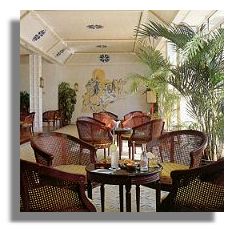
The success of letting property to visitors, and the continuing popularity of Madeira as a "resort island" led the young couple to plan the development of a hotel. They decided to invest in property and soon acquired the Quinta das Fontes and transformed it into the Royal Edinburgh Hotel - never to forget his Scottish roots. This required the permission of the then Duke of Edinburgh, Alfred, second son of Queen Victoria. As an officer with the Royal Navy he had frequently visited Madeira and had come to know William, who ignored all royal protocol and called him Auld Reekie!Next page > The Golden Book > Page 1, 2, 3, 4, 5, 6.
By the time Reid was 28 he had established Reid's Hotels, a group of small hotels including the Santa Clara and the Carmo. An advertising brochure of the time described these properties as
"First Class hotels, with every comfort for families and travellers. Excellent cuisine and Choice Wines. Tennis Courts, reading and smoking rooms. English and German newspapers. Billiards. All Steamers met."
(and adding the essential information)
"There is an absolute freedom from dust in Madeira"At the time there were very few hotels on the island and the Reid's business was a virtual monopoly at the end of the 19th century. Always the entrepreneur, seeking to improve and develop his business, William Reid had a dream. He wanted to build his own luxury hotel which would entice the rich and famous from all over the world. He had found the perfect site - a rocky cliff-top, 150 feet above the Atlantic, on the far west side of Funchal Bay.
The only stumbling block was the fact that a quinta was already built on the cliff top and owned by an English Doctor, Dr. Michael Grabham. But he was, in time, persuaded to sell the land and in 1887 Reid began to plan his dream hotel, commissioning the architect George Somers Clarke who had designed the Shepeard Hotel in Cairo, along with his partner, J. Micklethwaite. Apart from superb accommodation, first class service and cuisine, the hotel was to be surrounded by ten acres of beautiful sub-tropical gardens in which the guests could walk and rest and read in the warm sunshine. Before building began therefore, baskets of rich soil had to be carried by the Madeiran workers up the steep hill to create fertile land out of the barren rock into which a colourful and exotic array of plants, shrubs and trees were planted.
Tragically, William Reid was not able to celebrate the completion of his luxury hotel. Perhaps due to the immense effort and stress involved in the planning and creation his new hotel, the following year, in 1888, William died, aged just sixty-six. His two sons, already in the business as "Hotel Keepers and Wine Merchants" oversaw the project as their father would have done, with great attention to detail. In November 1891 Reid's Palace opened its doors for the first time offering drawing rooms opening onto a verandah, a tennis court, a path down to the rocks and a sea-level bathing pool. And of course the lush gardens.
An early visitor to Reid's at the turn of the century recalls:
"Broad masses of bougainvillea of every colour from purple and scarlet to terracotta make splashes that stand out even from the surrounding wealth of flowers. Bigoni in golden red lanes, wisteria with its lilac blossom hovering amidst the trees, solandra with its white and gold trumpet shaped flower, the blue and orange strelitzia regina, the scarlet passion flower - these along to bewilder the eye at the first glimpse."
The new Reid's Hotel with elaborate decoration and furnishings, the elegant dining room with marble pillars, painted ceiling and Italian chandeliers, comfortable lounges and spacious private suites was indeed the luxury Palace which William Reid had imagined it would be. A hotel to rival the glamour of Raffles in Singapore and the style of Ritz in London.
And it was the glamourous, stylish and seriously wealthy who were enticed to come and could afford to stay. Accommodation in a double room, with meals for a period of four weeks, was priced at around £ 22. Many guests would then bring their maids or servants (£ 6 each) and an extra charge for sitting rooms. (At this time a skilled engineer would be earning no more than £ 1.50 for a sixty hour week.) Prior to the modern convenience of telephone, fax and e mail, Reservations could be arranged by telegram. The cost however was 6 pence per word. The Reid brothers, inheriting their father's philosophy of thrift, devised a clever code reference, based on one single word to denote a certain type of accommodation: Single, Homely (2 double bedrooms) or Follower (sitting room, double bedroom and servant's room).



